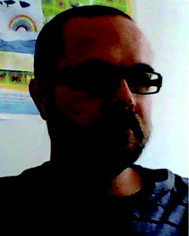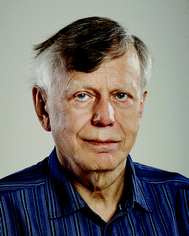A glance at achievements in analytical atomic spectrometry in Central and Eastern Europe
Paweł Pohl†a and Jiří Dědina†b
aWroclaw University of Technology, Wroclaw, Poland
bAcademy of Science of the Czech Republic, Prague, Czech Republic
 Paweł Pohl | Paweł Pohl is an associate professor of chemistry (2011) at Wroclaw University of Technology (Wroclaw, Poland), Faculty of Chemistry, Division of Analytical Chemistry from which he obtained PhD (2002) and DSc (2009) degrees. His research interests are focused on hyphenation of chromatographic separation and pre-concentration techniques with spectrometric methods of detection for speciation and fractionation analysis of metals and metalloids in environmental samples, food and beverages as well as development and application of chemical vapor generation technique for analytical atomic and mass spectrometries. |
 Jiří Dědina | Jiří Dědina is the Head of the Department of Trace Element Analysis (detached workplace situated in Prague, Czech Republic) of Institute of Analytical Chemistry of the AS CR, v. v. i. He also acts as an associate professor of analytical chemistry at Charles University in Prague, Faculty of Science. After obtaining his PhD (physical organic chemistry) in 1975, his research has focused on trace element analysis. His present scientific interests lie in (i) generation, collection and atomization of volatile species for trace and ultratrace element analysis and for speciation analysis by AAS and AFS and in (ii) mechanism of hydride atomization in flames, quartz tube atomizers and graphite furnaces. |
Dear Readers and Supporters of JAAS,
On behalf of the Editorial Board and ourselves, we are pleased to give back into your hands the themed issue on “Analytical atomic spectrometry in Central and Eastern Europe”, which was announced at the beginning of 2012. The idea of this issue was to introduce, to a greater international community of analytical chemists, areas of interest of researchers coming from countries in Central and Eastern Europe and their achievements in the field of analytical atomic and mass spectrometry.
The present online themed issue is a collection of seven papers of researchers from Bulgaria (Tsalev and Ivanova,1 Stefanova et al.2), Czech Republic (Hraníček et al.,3 Moraes et al.,4 Musil et al.5), Poland (Jamróz et al.6), Romania (Frentiu et al.7, Constantinescu et al.8) and Slovak Republic and Hungary (Andruch et al.9). The collection includes two reviews, one overview and six original research papers. It is worth noting that five of the six original papers are devoted to volatile species generation. We are pleased at that since both of us are heavily engaged in the field.
Accordingly, the paper by Frentiu et al.7 is dedicated to a new miniaturized measurement system, comprising a cold vapor generator, a gold filament microcollector, capacitively coupled plasma microtorch, and a miniaturized CCD spectrometer, for the optical emission spectrometry (OES) determination of Hg in water samples. It seems that this miniature system enables fast and reliable measurements of Hg at the sub-ng L−1 range. A comparison of different electrolytic cells and their performance for the electrochemical hydride generation of Se for sensitive measurements of this element by heated quartz tube (QT) atomic absorption spectrometry is the subject of the paper by Hraníček et al.3 For best thin-layer and tubular electrolytic cells, relatively high hydride generation efficiencies are achieved and hence, the use of these cells results in superior sub-μg L−1 detection limits of Se. There is a paper by Jamróz et al.6 on mixed argon–helium microwave induced plasma (Ar–He-MIP) combined with volatile species generation for the OES determination of As, Sb and Hg. Studying fundamental spectroscopic properties of the plasma, i.e., various optical temperatures and the electron number density, these authors explain the role and the beneficial effect of small quantities of He added to the Ar plasma gas on the analytical performance of the MIP system. Moraes et al.4 demonstrate the suitability of hydride generation-cryotrapping-gas chromatography-atomic absorption spectrometry for the speciation analysis of As in an antimony-containing drug (arsenites, arsenates and their mono-, di- and trimethyl-substitutes). The method offers a very good performance with minimum sample preparation at low investment and running costs and, what is very important, a lack of interferences from the antimony matrix. Musil et al.5 present a new analytical technique in which volatile Ag species, generated in the reaction with tetrahydroborate in a flow injection mode, are in situ collected and atomized in a new modular QT atomizer prior to AAS measurements of this element. As a result, under optimal conditions related to the generation of Ag species, their transport to the atomizer as well as trapping, volatilization and atomization temperatures, a very good analytical performance is achieved. Stefanova et al.2 propose the use of magnetic nanoparticles of MnFe2O4 as a new sorbent for the group retention of hydrophobic complexes of ammonium pyrrolidine dithiocarbamate with V, Co, Ni, Cu, Zn, As, Se, Cd and Pb and pre-concentration of these elements prior to their determination by inductively coupled plasma mass spectrometry (ICP-MS). This solid phase extraction procedure described gives detection limits in the interval of 0.01–0.7 μg L−1 while its suitability is illustrated by the analysis of human urine. There is a comprehensive review paper by Tsalev and Ivanova1 devoted to research studies of Bulgarian analytical atomic spectroscopists on applications of AAS, atomic fluorescence spectrometry (AFS), ICP-OES, ICP-MS and hyphenated techniques in the trace element analysis and the speciation published in the period 2000–2012.
Another review paper by Andruch et al.9 is devoted to on-line and off-line applications of dispersive liquid-liquid microextraction (DLLME) in the trace analysis and speciation studies of various elements by means of atomic and mass spectrometry detection methods. Finally, Constantinescu et al.8 overview achievements of their group on the application of X-ray based spectrometric methods in the elemental (Ag, Au, Cu, Fe, Sn and others) analysis of gold treasures found on the territory of Romania.
Certainly, this collection does not reflect a complete picture of research activities, objectives posed, problems solved and goals achieved in the field of analytical atomic spectrometry by analytical chemists and spectroscopists coming from Central and Eastern European countries. Nevertheless, thank you to all contributing authors, and we hope that you enjoy this collection of their articles and fruits of their work.
References
- D. L. Tsalev and E. Ivanova, J. Anal. At. Spectrom., 2012, 27(10), 1645–1657 RSC.
- V. Stefanova, D. Georgieva, V. Kmetov, I. Roman and A. Canals, J. Anal. At. Spectrom., 2012, 27(10), 1743–1752 RSC.
- V. Hraníček, V. Červený, J. Kratzer, M. Vobecký and P. Rychlovský, J. Anal. At. Spectrom., 2012, 27(10), 1761–1771 RSC.
- D. P. Moraes, M. Svoboda, T. Matoušek, E. M. M. Flores and J. Dědina, J. Anal. At. Spectrom., 2012, 27(10), 1734–1742 RSC.
- S. Musil, J. Kratzer, M. Vobecký and T. Matoušek, J. Anal. At. Spectrom., 2012, 27(9), 1382–1390 RSC.
- P. Jamróz, P. Pohl and W. Żyrnicki, J. Anal. At. Spectrom., 2012, 27(10), 1772–1779 RSC.
- T. Frentiu, A. I. Mihaltan, E. Darvasi, M. Ponta, C. Roman and M. Frentiu, J. Anal. At. Spectrom., 2012, 27(10), 1753–1760 RSC.
- B. Constantinescu, A. Vasilescu, D. Stan, M. Radtke, U. Reinholz, G. Buzanich, D. Ceccato and E. Oberlaender-Tarnoveanu, J. Anal. At. Spectrom., 2012, 27(12), 2076–2081 RSC.
- V. Andruch, I. S. Balogh, L. Kocúrová and J. Šandrejová, J. Anal. At. Spectrom., 2013, 28(1), 19–32 RSC.
Footnote |
| † Guest editor. |
| This journal is © The Royal Society of Chemistry 2013 |
